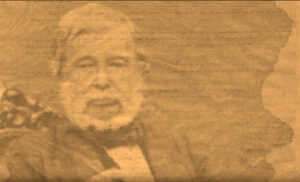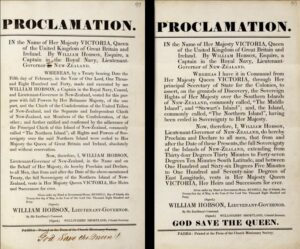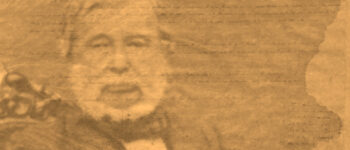1840: Sovereignty over Stewart Island
June 6, 2024
By AHNZ
 Today in history, 5 June, 1840, British Sovereignty over Stewart Island was proclaimed. The usual legal rituals were performed by the expedition of the HMS Herald. These involved landing marines and ship’s officers, raising the Union Jack, and firing some guns. They also buried a bottle with the necessary paperwork and, perhaps, some coins (since that is usual.) This formalised British possession due to James Cook’s discovery in 1770.
Today in history, 5 June, 1840, British Sovereignty over Stewart Island was proclaimed. The usual legal rituals were performed by the expedition of the HMS Herald. These involved landing marines and ship’s officers, raising the Union Jack, and firing some guns. They also buried a bottle with the necessary paperwork and, perhaps, some coins (since that is usual.) This formalised British possession due to James Cook’s discovery in 1770.
Where is this bottle now? It was placed in a prominent location easy to find again yet nobody has yet managed it.
Sovereignty might have been accomplished over 174,000 hectares of ports, beaches, fishing grounds, tin mines, forests, rivers, grazing lands, etc. via the Treaty of Waitangi. That was the mission of New Zealand’s new Lieutenant Governor William Hobson: To find willing communities in New Zealand who would sign up to his start-up government.
On 28 April Hobson had sent his Second in Command, Major Thomas Bunbury to accomplish this. Sailing on the Herald under Captain Joseph Nias the crew came back to Hobson in his new “capital” on 2 July with just 27 signatures despite this long and expensive trip. Nothing economically productive about it. However, it was necessary to go through these motions in order to achieve the political hegemony Hobson was after that required the backing of the Empire for his little gang to succeed in this major coup in the south seas.
However, at Stewart Island there was nobody to sign Hobson’s Treaty. The natives had annihilated themselves in a vicious civil war and then mopped up by invading tribes from the north over the last 2 generations. The Herald-Bunbury Treaty Sheet had gained just 2 signatories (“scarcely chiefs” admits Bunbury) in all Canterbury and now zero on Stewart Island. However, Bunbury found 3 chiefs at nearby Ruapuke¹ Island including Bloody Jack Tuhawaiki and took their marks for the document.
Bunbury had been joined on this historic occasion, quite appropriately, by Captain William Stewart himself. On 8 May Herald collected him from the Coromandel so he could guide them to ‘his’ island. It was Stewart as First Mate of the Pegasus who mapped and circumnavigated the island on 22 January, 1809. Since then Stewart had established an impermanent trading port there. According to Midshipman Comber’s Journal the Captain was anxious that the new Hobson Government was going to take his island from him. That Stewart had thrown in his lot with would-be Sovereign King of New Zealand Baron de Thierry in the 1820s was not in his favor.
Monty Python put it into perspective saying “Strange women lying in ponds distributing swords is no basis for a system of government.” What de Thierry and Stewart tried to do, and what James Busby, and what William Hobson tried to do was really no different. It’s just that the Hobson Gang with guns and flags and bottles in the dirt carried the day where others failed.
“The 100th anniversary of the declaration of British sovereignty over Stewart Island will be commemorated at Port Pegasus on June 5. Further efforts will be made before June to determine, if possible, the exact site where the bottle containing the proclamation of sovereignty in the name of Queen Victoria was buried by the party from H.M.S. Herald. The location is an intriguing mystery to Stewart Islanders, New Zealand historians and the British Admiralty.” – Waikato Times (1940,) Papers Past
“Where are you Maoris? Where are you Maoris?” – Mike King, Lost in Translation (2009,) NZ on Screen
“Despite this long voyage Bunbury gathered only 27 signatures, but he did proclaim sovereignty over Stewart Island (where no Mäori were found) by discovery, and over the “middle island” (now the South Island). The Herald copy is on parchment and suffered severe damage from its later encounter with rats. The copy bears Hobson’s normal signature, and the handwriting suggests that it was written by Henry Tacy Kemp, one of the government’s best translators.” – The Journey of the Treaty, State Services Commission (2005,) nzhistory.govt
“I disembarked with Mr. Williams and Captain Stewart; the latter from his personal acquaintance with the native chiefs of the Middle Island, and their language, I have found very useful. The language I am told by Mr. Williams, differs considerably from that of the northern island…There being little probability of our finding any natives on the island, Captain Nais and myself deemed it advisable the same day to proclaim the Queen’s authority over the island, for which purpose the marines were landed with a party of officers from the ship, and the usual forms complied with. The original of this declaration of the right of sovereignty enclosed in a bottle, was buried on a small island near the anchorage, which becomes a peninsula at low water.” – Bunbury, Reminiscences of a Veteran (1861,) ENZB
“HMS Herald was away discovering tribes, giving them a crash-course in handwriting, and getting them to use their new penmanship to sign away their sovereignty to New South Wales for Queen Victoria. Hobson wouldn’t know until his gang affiliates on Herald, Captain Joseph Nias and Major Thomas Bunbury, returned with the Herald-Bunbury Copy of the Treaty on July 2nd how things turned out.” – 1840: The Proclamations of Sovereignty, AHNZ
 Thus Stewart’s Island became part of the Crown Colony of New Zealand. Although, it was more to shore up what Hobson had already done in ‘crowning’ himself earlier in the year the Lieutenant Governor of New Zealand. This he did before presenting anyone with his Treaty. Ref. 1840: Hobson Crowns Himself, AHNZ
Thus Stewart’s Island became part of the Crown Colony of New Zealand. Although, it was more to shore up what Hobson had already done in ‘crowning’ himself earlier in the year the Lieutenant Governor of New Zealand. This he did before presenting anyone with his Treaty. Ref. 1840: Hobson Crowns Himself, AHNZ
Likewise, Hobson had already declared himself master of Stewart Island the on 21 May using the Proclamations of Sovereignty and doctrine of Discovery. Hobson claimed to have “a perfect knowledge of the uncivilized state of the natives” in doing so. Bunbury’s exploits simply added more legal weight.
The Bunbury bottle has been lost to history but would make a wonderful find. As would the one James Cook left at Queen Charlotte Sound in 1770 with its coins of the realm, bullets, papers etc.
As Stewart had made the map of the island 30 years before and it was still in high regard in 1840 it seems like the tidal island with the bottle on it shouldn’t be too hard to find on that old map. And, so, not too hard to trace in 1940 or even today. However, nobody has yet done so and made it public.
On 29 June, 1864, the government returned to Foveaux Strait. This time, to purchase Stewart Island itself for the Crown. The Rakiura Deed was handled by Commissioner Henry Clarke and Maori title extinguished. The terms were generous, especially since very few Maoris were to be found on the island. However, on this occasion 120 Maoris showed up to facilitate getting paid. It was handled from Bluff which goes to show there were no facilities for gatherings on Stewart Island in June 1864 any more than there were in June 1840.
Stewart Island has yet to leave any prominent marks on New Zealand’s history so it hasn’t attracted too much government interference either. For that those who are at home there are blessed.
—
1 According to Bunbury this island was home to cassiowary. If so I suspect some Australian jokers had put them there during the days of sealing. Ref. Reminiscences of a Veteran (1861)
Image ref. Thomas Bunbury superimposed over the Bunbury-Herald Treaty Sheet; AHNZ (2024)
See also 1985: GMV Wairua, AHNZ
See also Muttonbirders’ Customary Rights Under Threat, AHNZ
2 thoughts on "1840: Sovereignty over Stewart Island"
Leave a Reply
 Like Comment Share
Like Comment Share






I learnt much from your research and pithy dialogue, a great read, cheers.
Cheers. It’s interesting that our only main island that has a proper name is so little known. That is, who today knows much about William Stewart’s life?